After a rogue wave strike in the Bering Sea, the trawler Progress goes under
the knife to be sponsoned and lengthened at Fred Wahl’s yard in Oregon
Just before dawn on Jan. 26, 2018, Capt. Tiffany McKenzie took over the watch on the 114-foot trawler F/V Progress, as she, her three-man crew, and one observer waited to begin fishing for pollock in the Bering Sea.

This story was first published in the July issue of National Fisherman. Subscribe today for digital and print access.
“They were calling for NW 35, but it was NE 70,” says McKenzie. “We were about 35 miles northeast of Cape Mordinof, Unimak Island, jogging at 1.5 knots. It was pretty bad, and I was quartering it. Then I saw this wave coming. It was 30 or 40 feet. The thing was, it had a curl on top, and that’s what got us. It took out six windows.”
“How was that?” I was almost embarrassed to ask.
“Wet!” McKenzie says, in answer to my absurd question.
“What were you thinking at the time?”
“I was thinking, I’m wet!”
So were the electronics. Thousands of gallons of seawater had poured into the wheelhouse, and from there to the galley and engine room below. McKenzie temporarily lost the steering and throttle. But she has a 1,600-ton, nearshore, master’s ticket with numerous certifications, including damage control. She and her crew had done an emergency drill just 10 days prior to the accident, and in half an hour, they had the boat under control.
McKenzie turned to run with the seas, but the wave had knocked out all the boat’s radios. She activated an EPIRB to alert the Coast Guard and nearby vessels that they were in distress. A little while later they got a radio functioning and made contact with the Coast Guard. The Progress had lost all its navigation equipment, so nearby vessels escorted her back to Dutch Harbor, where she arrived the next day.
From Dutch Harbor, the vessel owners, Evening Star Fisheries, had the boat towed 1,800 miles to Fred Wahl Marine Construction and Fabrication in Reedsport, Ore., a few hours south of the Progress’s home port of Newport.
“The owners contacted us a couple of weeks after the accident,” says Hal Hockema, president and principal at Hockema Whalen Myers Associates. “The vessel had major structural and internal damage. The pilothouse was damaged. They wanted us to investigate to see whether they wanted to repair or rebuild.”
Hockema presented the owners with a suite of options from basic repair to a total rebuild that included sponsons, lengthening the vessel, and adding a larger pilothouse. Evening Star chose the latter — deciding to add 5-foot sponsons and lengthen the vessel by 15 feet. And so began a project that asked the most of some of the best people in the business, many of whom had a long history with the Progress.
“I was a month out of high school when Wilburn Hall brought her down to Newport,” says Hockema. “At the time, I was leaning toward a career in naval architecture. The Progress was one of the large commercial fishing vessels being built at the time that cemented my interest in naval architecture. I just thought these vessels were really cool.”
To read the full article, subscribe to National Fisherman today for digital and print access.







